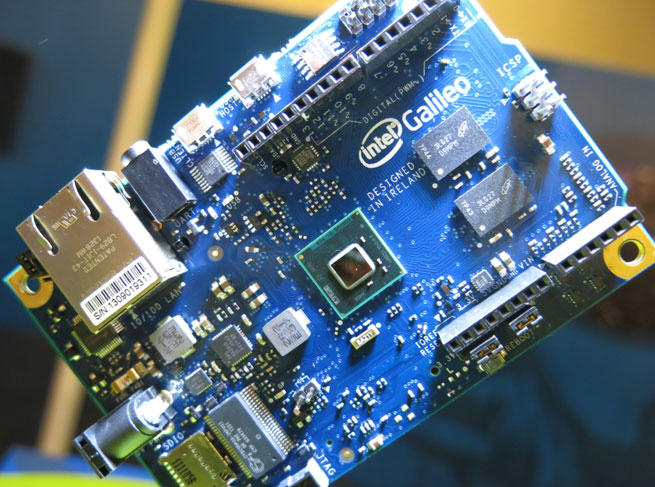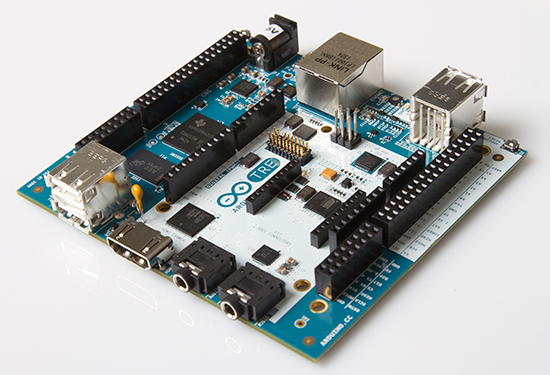Recently in Maker Faire Rome, Arduino announced two new Linux based Arduino boards – Galileo in collaboration with Intel (Yes 😉 ) and Arduino TRE in collaboration with Texas Instruments (the company behind BeagleBoard). Together with Arduino Yun, now the total number of official Arduino Linux based boards is 2.
Intel Galileo
This board is created in collaboration with Intel and will be called Intel Galileo instead of Arduino Galileo. It is an Arduino certified board, the first one of this category and I guess that is the reason it is called Intel Galileo and not Arduino Galileo. This board was announced by Massimo Banzi along with Intel CEO Brian Krzanich in Maker Faire Rome.
Galileo is a microcontroller board based on the Intel® Quark SoC X1000 Application Processor, a 32-bit Intel Pentium-class system on a chip. And the Arduino website claims that this will be a great tool for prototyping simple interactive LED light displays and to create home automation solutions.
Intel Galileo will be available for purchase from November 19 – 2013, but the pricing information is still not available.
Arduino TRE
The second board which was announced (also in Maker Faire Rome) is Arduino TRE, which was developed in collaboration with Texas Instruments.
Arduino TRE is a combination of two Arduinos, which is quite clear if you look at the above image. One is based on the Texas Instruments Sitara AM335x ARM Cortex-A8 processor and the other is a AVR-based Arduino. This board will be able to run “full Linux”, not a stripped down version like Arduino Yun. Arduino website also claims that this is the “most powerful Arduino to date”.
Arduino TRE, based on the Texas Instruments Sitara AM335x ARM Cortex-A8 processor is the “most powerful Arduino to date” and the first that will be able to run “full Linux.”
Thanks to the 1-GHz Sitara AM335x processor, Arduino developers get up to 100 times more performance with the Sitara-processor-based TRE than they do on the Arduino Leonardo or Uno. This performance opens the doors to more advanced Linux-powered applications. The Sitara-processor-based Linux Arduino can run high-performance desktop applications, processing-intensive algorithms or high-speed communications.
Arduino TRE will be available for purchase from Spring 2014, but the pricing information is still not available.
How it compares with Raspberry Pi?
It is pretty clear, that both these boards and also Yun have been motivated by Raspberry Pi, but the real question is how does these boards compare with Raspberry Pi?
I would say that either Arduino Yun or TRE is comparable with Raspberry Pi, since both can run Linux. Intel Galileo falls into the class of Arduino Due, which are slightly different from Raspberry Pi.
I guess both cost and ease of programming would be crucial factors in deciding between Arduino and Raspberry Pi. Arduino Yun itself is priced at $69, so definitely Arduino TRE will cost more than that, which means Raspberry Pi is going to have a clear advantage here.
But I guess in the ease of programming perspective, Arduino might have an upper hand. I guess the Bridge library which was created for Arduino Yun will be extended for Arduino TRE as well. The Bridge library provides very simple Arduino friendly API’s to access and control Linux and I guess that may be a huge game changer.
So at this point, I guess we can only speculate. It would be really interesting to see how things unfold. But one thing is certain, the future for makers and tinkers is bright 🙂
Happy Hacking 😉


This is great. Helps solve compatibility issues. Hope Arduino shields and IDE can be used with these boards.
TRE looks like a arduino placed on an extended Beaglebone black.
> Hope Arduino shields and IDE can be used with these boards.
I am definitely sure that we will be able to use Arduino IDE. But regarding shields, I guess most of them should be compatible.